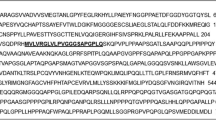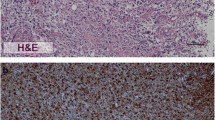Summary
Two human cell lines (GL15 and GL22) derived from glioblastoma multiforme were established and characterized by immunohistochemical and cytogenetic techniques. The expression of glial fibrillary acidic proteins and the karyotype were analyzed at different passages for both cell lines. The course of marker-pattern differed in the two cell lines. The main findings were a cell-density-dependent expression of glial fibrillary acidic protein in the cell line GL15 at all passages and a decreased expression of this protein over time in the cell line GL22. Both cell lines had hyperdiploid karyotypes and exhibited glioma-specific chromosomal abnormalities (gain of chromosome 7 and loss of chromosome 10). In the GL15 cell line no relevant chromosomal changes were produced during culturing, whereas in the GL22 cell line a hypodiploid clone appeared at the 42nd passage. The immunohistochemical and cytogenetic data resulting from this study confirm that the two cell lines established in our laboratory originated from astrocytic tumor cells.
Similar content being viewed by others
Abbreviations
- MHG :
-
malignant human gliomas
- GFAP :
-
glial fibrillary acidic protein
- DMEM :
-
Dulbecco's modified Eagle's medium
- FCS :
-
fetal calf serum
- GTG :
-
banding trypsin-Giemsa banding
- TBS :
-
TRIS-buffered saline 10 mM pH 7.6
- p :
-
short arm of chromosome; q long arm of chromosome
- der:
-
derivative chromosome
References
Bignami E, Eng LF, Dahl D, Yeda CT (1972) Localization of the glial fibrillary acidic protein in astrocytes by immunofluorescence. Brain Res 43:429–435
Bigner DD, Bigner SH, Ponten J, Westermark B, Mahaley MS, Ruoslahti E, Herscheman H, Eng FL, Wikstrand CJ (1981) Heterogeneity of genotypic and phenotypic characteristics of fifteen permanent cell lines derived from human gliomas. J Neuropathol Exp Neurol 40:201–227
Bigner SH, Mark J, Burger PC, Mahaley MS, Bullard DE, Muhlbaier LH, Bigner DD (1988) Specific chromosomal abnormalities in malignant human gliomas. Cancer Res 88:405–411
Casalone R (1989) Cytogenetics of human gliomas. In: Broggi G, Gerosa MA (eds) Cerebral gliomas. Elsevier, Amsterdam, pp 9–12
Chen IR (1977) In situ detections of mycoplasma contamination in cell cultures by fluorescent Hoechst 33258 stain. Exp Cell Res 104:255–262
Dewhurst S, Stevenson M, McComb RD, Volsky DJ (1987) Expression of glial fibrillary acidic protein in human glioma cell lines as detected by molecular hybridization. Acta Neuropathol 73:383–386
Duffy PE (1983) Incidence and pathology of astrocyte tumors. In: Astrocytes: normal, reactive and neoplastic. Raven Press, New York, pp 119–160
Frame MC, Freshney RI, Vaughan PTF, Graham DI, Shaw R (1984) Interrelationship between differentiation and malignacyassociated properties in glioma. Br J Cancer 49:269–280
ISCN (1985) An international system for human cytogenetic nomenclature. Harnden DG, Kingler HP (eds) Published in collaboration with Cytogenet Cell Genet. Karger, Basel
Jenkins RB, Kimmel DW, Moertel CA, Schultz CG, Scheithauer BW, Kelly PJ, Derwald GW (1989) A cytogenetic study of 53 human gliomas. Cancer Genet Cytogenet 39:253–279
Kennedy PGE, Watkins A, Thomas DGT, Noble MD (1987) Antigenic expression by cells derived from human gliomas does not correlate with morphological classification. Neuropathol Appl Neurobiol 13:327–347
Nishyama A, Onda K, Washiyama K, Kumanishi T, Kuwano R, Sakimura K, Takahashi Y (1989) Differential expression of glial fibrillary acidic protein in human glioma cell lines. Acta Neuropathol 78:9–15
Osborn M, Ludwig-Festl M, Weber K, Bignami A, Dahl D, Bayreuther K (1981) Expression of glial and vimentin type intermediate filaments in cultures derived from human glial material. Differentiation 19:161–167
Rutka JT, Giblin JR, Dougherty DY, Liu HC, McCulloch JR, Bell LW, Stern RS, Wilson CB, Rosenblum ML (1987) Establishement and characterization of five cell lines derived from human malignant gliomas. Acta Neuropathol 75:92–103
Schnegg JF, Diserens AC, Carrel S, Accolla RS, Tribolet N de (1981) Human glioma-associated antigens detected by monoclonal antibodies. Cancer Res 41:971–972
Studer A, Tribolet N de, Diserens AC, Gaide AC, Matthieu JM, Carrel S, Stavrou D (1985) Characterization of four human malignant glioma cell lines. Acta Neuropathol 66:208–217
Trent J, Meltzer P, Rosemblum M, Harsh G, Kinzler K, Mashal R, Fleinberg A, Vogelstein B (1986) Evidence for rearrangement, amplification and expression of c-myc in a human glioblastoma. Proc Natl Acad Sci USA 83:470–473
Westphal M, Nausch H, Hermann HD (1990) Antigenic staining patterns of human glioma cultures: primary cultures, long-term cultures and cell lines. J Neurocytol 19:466–477
Author information
Authors and Affiliations
Rights and permissions
About this article
Cite this article
Bocchini, V., Casalone, R., Collini, P. et al. Changes in glial fibrillary acidic protein and karyotype during culturing of two cell lines established from human glioblastoma multiforme. Cell Tissue Res 265, 73–81 (1991). https://doi.org/10.1007/BF00318141
Accepted:
Issue Date:
DOI: https://doi.org/10.1007/BF00318141




